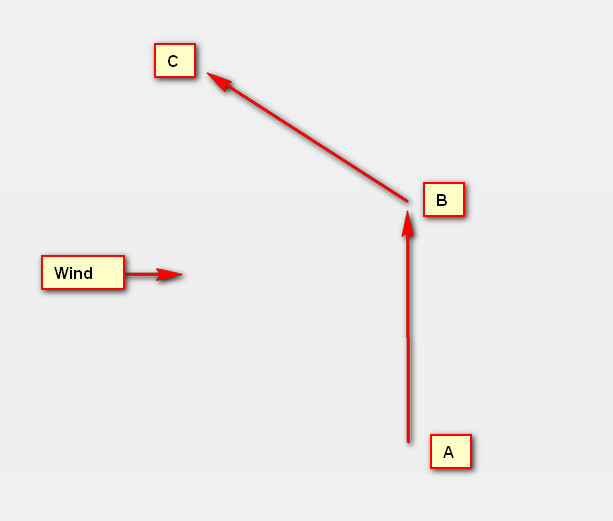
There will be negligible headwind A-B, and a bit B-C. But if you get a shortcut A-C, you get the headwind component all along A-C. But the A-C headwind component will be smaller than the B-C one.
Intuitively it seems obvious that this proposition is impossible i.e. a shortcut will always take less time.
But maybe not, if you carry out a standard engineering thought experiment: consider an extreme case of wind velocity versus aircraft TAS. You can obviously easily get an infinite flight time, if say the headwind component is 50kt and the TAS is 50kt (or less). So a scenario where that happened on any leg would be a clear counter example, because that leg alone – no matter how short it is – would ensure the aircraft never arrives.
Sailing boats on the water and longrange airliners in jetstream flightlevels do it all the time …
It makes no sense to ask for a direct when that puts you into a 150kt headwind for a longer period of time. The global wind data have become so precise that computer programs can easily compute a route that offers the minimum flight time, which is what you want, not the minimum track miles.
A DIRECT may not be the quickest path indeed, but this has to do with wind variations along the route. With a constant wind throughout the area, it’s always quicker to go direct (great circle, to be precise). Don’t forget that a crosswind also slows you down: in your extreme example, a crosswind of 50 kt with TAS of 50 kt gives you a GS of 35 kt.
I was not thinking about varying winds. It is obvious that a 1000kt wind which affects one piece of the route will blow you away 
I was taking the scenario where the wind vector is the same everywhere. That is the case nearly always in GA, roughly speaking.
Peter wrote:
I was taking the scenario where the wind vector is the same everywhere. That is the case nearly always in GA, roughly speaking.
In that case a direct is always faster.
Jason
Example: the track from a→ c is 315, the (slow) airplane does 50knots, the wind is 135/50
direct track a-c the plane wont ever get there.
say a-b track is 360. Plane will get to b with drift adjusted heading because it is all not head wind.
b-c track is 270. plane will get to c with drift adjusted heading because it is all not head wind.
Therefore a..b..c is faster than a to c.
Do you still say a to c is always faster ?
As long as you have 50 kts wind and 50 kts TAS, you won’t get anywhere no matter your intended heading, since you need all your speed just to remain stationary. So I am with Jason here.
liftvectorup wrote:
Example: the track from a→ c is 315, the (slow) airplane does 50knots, the wind is 135/50
Surely you mean the wind is 315/50!?
say a-b track is 360. Plane will get to b with drift adjusted heading because it is all not head wind.
No, it won’t. Dig out your E6B or other favourite tool and try it. It is not “all head wind” on that leg, but your resulting speed vector will not take you closer towards B (or C, for that matter). If the headwind on your intended route exceeds your TAS, you will not get there, no matter which intermediate waypoints you choose.
Indeed. Think of it this way. If you are at A trying to get to C and if the wind is blowing from C towards A at 50 knots, the only way to get closer to C is for the component of your velocity aligned with the wind to exceed 50 knots. Otherwise you must be blown away from C. With a TAS of 50kts, If you try to fly direct you will be stationary wrt to the ground. If you turn you will go backwards wrt to C while moving from side to side.
And the time it takes depends on your TAS and the distance you must fly through the (moving) air mass.
A direct is the fastest route given constant wind and TAS.
If headwind is greater or equal than TAS, then you can’t go towards the wind or at any angle that has any headwind component. So, you only have available a 180 arc that’s is away from wind and you’ll never reach your target.